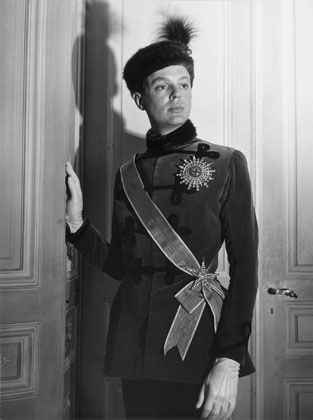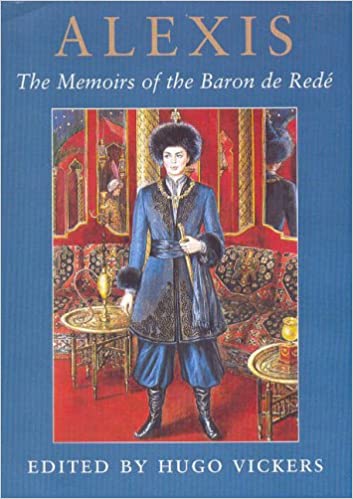BURIED TOGETHER
Partner
Arturo López Willshaw
Queer Places:
Institute Le Rosey, Château du Rosey, 1180 Rolle, Svizzera
Hôtel Lambert, 4 Rue Saint-Louis en l'Île, 75004 Paris, Francia
Père-Lachaise cemetery, 16 Rue du Repos, 75020 Paris
 Oskar Dieter Alex von Rosenberg-Redé, 3rd Baron von Rosenberg-Redé[1] [2] [3] [4] (4 February 1922 – 8 July 2004), also known as Alexis, Baron de Redé, was a prominent French banker, aristocrat, aesthete, collector,[5] and socialite. Rede expired “in a second” after his heart stopped at the American Hospital, where he had gone for tests, said
Pierre Bergé, one of Rede’s close friends.
Nancy Mitford dubbed him “La Pompadour de nos jours.” He hosted more memorable parties and dinners, promoting young couturiers such as
Pierre Cardin and
Yves Saint Laurent in the process by asking them to whip up costumes and decors.
"I am not a philosopher," Redé explained in his autobiography, which was edited by
Hugo Vickers, a British writer known for his magisterial biography of the photographer
Cecil Beaton. "I live for elegance and taste."
Oskar Dieter Alex von Rosenberg-Redé, 3rd Baron von Rosenberg-Redé[1] [2] [3] [4] (4 February 1922 – 8 July 2004), also known as Alexis, Baron de Redé, was a prominent French banker, aristocrat, aesthete, collector,[5] and socialite. Rede expired “in a second” after his heart stopped at the American Hospital, where he had gone for tests, said
Pierre Bergé, one of Rede’s close friends.
Nancy Mitford dubbed him “La Pompadour de nos jours.” He hosted more memorable parties and dinners, promoting young couturiers such as
Pierre Cardin and
Yves Saint Laurent in the process by asking them to whip up costumes and decors.
"I am not a philosopher," Redé explained in his autobiography, which was edited by
Hugo Vickers, a British writer known for his magisterial biography of the photographer
Cecil Beaton. "I live for elegance and taste."
Oskar Dieter Alex von Rosenberg-Redé[6] was born in Zurich, Switzerland, the younger son and third and youngest child of Oskar Adolf von Rosenberg-Redé, 1st Baron von Rosenberg-Redé (1878–1939), a banker from Austria-Hungary.[7] His father—whose mother was Hungarian, whose father was unknown, and who was adopted by a banker by the name of Rosenberg—became a citizen of Liechtenstein and was created a baron by the Emperor of Austria in 1916.[8] [9] [10] Alexis's mother was Edith von Kaulla, a member of an ennobled German Jewish family that had been part-owners of the Bank of Württemberg. Redé was educated at Le Rosey in Switzerland, the school Bergé calls “the chicest in the world.” The Baron’s fellow pupils included Prince Rainer of Monaco and the future Shah of Iran..
He had two siblings: Hubert von Rosenberg-Redé, 2nd Baron von Rosenberg-Redé (1919–1942) andd Marion von Rosenberg-Redé (born 1916), who was handicapped.[11]

Alexis de Rede by Anthony Christian
Following the suicide of his father in 1939 at the family's estate (''Villa Rosin'') in the Austrian town of Kaumberg, Redé moved to New York City, where he briefly attempted to acquire American citizenship.[12] [13] His brother committed suicide in Hollywood in 1942, whereupon Redé became the third and last Baron von Rosenberg-Redé, which was typically abbreviated as ''Baron de Redé'' in France. In 1946, he returned to Paris, in the entourage of Elsie de Wolfe. Legend has it that
Arturo López Willshaw, who was married to his cousin, Patricia, offered Rede $1 million to return with him to Paris, where he had a house in the posh neighborhood of Neuilly. The handsome Rede is said to have demurred at first. "I was not in love," Redé recalled of their initial assignation. "But I needed protection, and I was aware that he could provide this."
Surrounded by Arturo Lopez, then knowing
Charles de Beistegui, knowing
Emilio Terry,
Georges Geoffroy,
Christian Berard, knowing all the people who had taste at that time —
Marie-Laure de Noailles
— if you didn’t get something from them, you had nothing.
Redé was a committed aesthete. In 1949, he moved into the ground floor of the 17th century Hôtel Lambert on the Île Saint-Louis in Paris and restored the building and its décor. In 2003, he was appointed a ''commandeur'' of the Ordre des Arts et des Lettres,[14] for his restoration of the Hôtel Lambert.[15]
Redé's notoriety rested on being a kept man. His wealth derived from his lover,
Arturo López Willshaw, a married Chilean millionaire, who settled $1 million on Redé shortly after they became a couple. Lopez-Willshaw, however, continued to maintain a formal residence with his wife, Patricia, in Neuilly. As Redé recalled of the beginning of his relationship with Lopez-Willshaw, which commenced in 1941 when he was 19, "I was not in love. But I needed protection, and I was aware that he could provide this." In addition, he observed, "The money gave me the security I craved, and it would also enable me to look after my handicapped sister."
In 1953, author Christian Mégret published ''Danaé'', a roman à clef based on Redé's and Lopez-Willshaw's life together. The racy details were provided by one of their close friends and Mégret's companion, Ghislaine, Princess de Polignac.[16] [17]
“The first time Rede asked Yves Saint Laurent to do something was in 1956, before Yves succeeded Christian Dior,” said
Pierre Bergé. “He asked him to decorate the Hotel Lambert for the Bal des Tetes. Yves made huge pyramids out of pineapples.” Saint Laurent designed hats and coiffures for the party, too.
Lopez-Willshaw's wife, a first cousin born Patricia Lopez-Huici, was cool towards her husband's companion, though the three often traveled together and attended social events as a group.[18] In 1962, when Arturo Lopez-Willshaw died, Redé inherited half of his fortune. To manage it, he joined Prince Rupert Loewenstein in taking control of Leopold Joseph & Sons, a bank where he served as the deputy chairman. With Loewenstein, Redé was closely involved in managing the money of the Rolling Stones. He was also a founder of Artemis, an investment fund specializing in the purchase of fine art.
After Lopez-Wilshaw’s death, Rede forged the second great friendship of his
life with Marie-Hélène de Rothschild. The two teamed up on many of the
legendary balls Rothschild threw at Ferrières, the Rothschild chateau east of
Paris. In 1975, he persuaded her and her husband, the Baron Guy, to purchase
the Hotel Lambert. They allowed Rede to keep his apartments and they shared
the house until the Baron’s death. “We did everything together,” recalled
Rothschild. “He lived 30 years with us. We went on vacation together. He was
the perfect friend.” After Marie-Hélène died in 1996, Rede grew close to
Charlotte Aillaud, sister of the French chanson legend Juliette Greco. The two
were inseparable.
Redé was described as "the Eugène de Rastignac of modern Paris" by Sir Henry 'Chips' Channon and as "the best host in all Europe"; his parties were the center of ''le tout-Paris''.[19] Philippe Jullian described the world of Lopez-Willshaw and Redé as like a small 18th-century court. Members of the circle included the poet and patron of the Surrealists, Marie-Laure de Noailles (1902–70); musicians such as Henri Sauguet, Georges Auric, and Francis Poulenc; and the artist
Christian Bérard. Important influences were the interior decorators
Georges Geffroy and Victor Grandpierre. Nina Ricci designed the costumes of Redé and the Lopez-Willshaws for the famous 1951 ''Bal oriental'' given by Carlos de Beistegui at his Venetian palace, the Palazzo Labia.[20]
In 1956, at Redé's ''Bal des Têtes'', the young Yves Saint Laurent provided many of the headdresses—the Duchess of Windsor being one of the judges—and received a boost to his career. When Diana Vreeland heard of the plans for Redé's ''Bal oriental'' in 1969, she promptly contacted Redé and expressed her interest in having the event photographed for Vogue.[21] The guest list was the crème de la crème of international high society.
In 1972, Redé had his portrait painted by the fashionable painter
Anthony Christian. In that year, he was also named in the International Best Dressed List Hall of Fame.[22] [23]
In 1975, the Hôtel Lambert was purchased by Baron Guy de Rothschild, whose wife, Marie-Hélène de Rothschild, was a close friend of Redé. The Rothschilds henceforth used it as their Paris residence.
Redé died suddenly at the home of a friend, Carmen Saint, at the age of 82. An intimate mass was celebrated July 13 at Saint Louis en L’Isle, the church near Rede’s residence at the Hotel Lambert. He then was interred in a private ceremony. His body was laid in a crypt at Père Lachaise near that of his mentor, Arturo Lopez-Wilshaw. His memoirs, ''Alexis: The Memoirs of the Baron de Redé'', were published posthumously in 2005. Hugo Vickers was its editor and ghostwriter.[24]
Redé's estate (notably the contents of his apartment at the Hôtel Lambert) was auctioned after his death by Sotheby's and realized £5.2 million.[25]
My published books:


BACK TO HOME PAGE

 Oskar Dieter Alex von Rosenberg-Redé, 3rd Baron von Rosenberg-Redé[1] [2] [3] [4] (4 February 1922 – 8 July 2004), also known as Alexis, Baron de Redé, was a prominent French banker, aristocrat, aesthete, collector,[5] and socialite. Rede expired “in a second” after his heart stopped at the American Hospital, where he had gone for tests, said
Pierre Bergé, one of Rede’s close friends.
Nancy Mitford dubbed him “La Pompadour de nos jours.” He hosted more memorable parties and dinners, promoting young couturiers such as
Pierre Cardin and
Yves Saint Laurent in the process by asking them to whip up costumes and decors.
"I am not a philosopher," Redé explained in his autobiography, which was edited by
Hugo Vickers, a British writer known for his magisterial biography of the photographer
Cecil Beaton. "I live for elegance and taste."
Oskar Dieter Alex von Rosenberg-Redé, 3rd Baron von Rosenberg-Redé[1] [2] [3] [4] (4 February 1922 – 8 July 2004), also known as Alexis, Baron de Redé, was a prominent French banker, aristocrat, aesthete, collector,[5] and socialite. Rede expired “in a second” after his heart stopped at the American Hospital, where he had gone for tests, said
Pierre Bergé, one of Rede’s close friends.
Nancy Mitford dubbed him “La Pompadour de nos jours.” He hosted more memorable parties and dinners, promoting young couturiers such as
Pierre Cardin and
Yves Saint Laurent in the process by asking them to whip up costumes and decors.
"I am not a philosopher," Redé explained in his autobiography, which was edited by
Hugo Vickers, a British writer known for his magisterial biography of the photographer
Cecil Beaton. "I live for elegance and taste."


